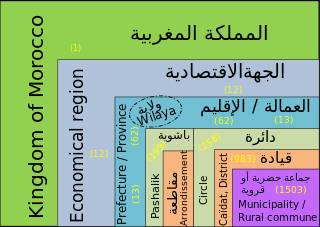Regions of Morocco
| Regions of Morocco جهات المغرب (Arabic) ⵜⵉⵎⵏⴰⴹⵉⵏ ⵏ ⵍⵎⵖⵔⵉⴱ (Standard Moroccan Berber) | |
|---|---|
 Morocco provinces | |
| Category | Unitary state |
| Location | Kingdom of Morocco |
| Number | 12 Regions |
| Populations | 142,955 (Dakhla-Oued Ed-Dahab) – 6,861,737 (Casablanca-Settat) |
| Government |
|
| Subdivisions | |


Regions are currently the highest administrative divisions in Morocco. Since 2015, Morocco officially administers 12 regions, including one (Dakhla-Oued Ed-Dahab) that lies completely within the disputed territory of Western Sahara and two (Laâyoune-Sakia El Hamra and Guelmim-Oued Noun) that lie partially within it. The regions are subdivided into a total of 75 second-order administrative divisions, which are prefectures and provinces.[1]
A region is governed by a directly elected regional council. The president of the council is responsible for carrying out the council's decisions. Prior to the 2011 constitutional reforms, this was the responsibility of the Wali, the representative of the central government appointed by the King, who now plays a supporting role in the administration of the region.[2]
Regions since 2015[]
On 3 January 2010, the Moroccan government established the Consultative Commission for the Regionalization (CCR), which aimed to decentralize power to the regions, and confer a greater autonomy to the regions coinciding with the Western Sahara. The commission published provisional names and numbers for the new regions,[3] and their names were officially fixed in the Bulletin Officiel dated 5 March 2015.[4] The new regional councils elected their presidents on 14 September 2015[5] and regional governors were appointed on 13 October 2015.[6]
| Map number |
Region | Capital | Population (2014)[7] |
|---|---|---|---|
| 1 | Tanger-Tétouan-Al Hoceïma | Tangier | 3,556,729 |
| 2 | L'Oriental | Oujda | 2,314,346 |
| 3 | Fès-Meknès | Fès | 4,236,892 |
| 4 | Rabat-Salé-Kénitra | Rabat | 4,580,866 |
| 5 | Béni Mellal-Khénifra | Béni Mellal | 2,520,776 |
| 6 | Casablanca-Settat | Casablanca | 6,861,739 |
| 7 | Marrakech-Safi | Marrakech | 4,520,569 |
| 8 | Drâa-Tafilalet | Errachidia | 1,635,008 |
| 9 | Souss-Massa | Agadir | 2,676,847 |
| 10 | Guelmim-Oued Noun[A] | Guelmim | 433,757 |
| 11 | Laâyoune-Sakia El Hamra[A] | El Aaiun | 367,758 |
| 12 | Dakhla-Oued Ed-Dahab[A] | Dakhla | 142,955 |
A.^ Lies partially or completely within the disputed territory of Western Sahara.



1997 to 2010: Full unitary system[]
Between 1997 and 2010, Morocco had 16 regions.[8]

| Map number |
Region | Capital |
|---|---|---|
| 1 | Oued Ed-Dahab-Lagouira | Dakhla |
| 2 | Laâyoune-Boujdour-Sakia El Hamra | Laâyoune |
| 3 | Guelmim-Es Semara | Guelmim |
| 4 | Souss-Massa-Drâa | Agadir |
| 5 | Gharb-Chrarda-Béni Hssen | Kénitra |
| 6 | Chaouia-Ouardigha | Settat |
| 7 | Marrakech-Tensift-El Haouz | Marrakesh |
| 8 | Oriental | Oujda |
| 9 | Grand Casablanca | Casablanca |
| 10 | Rabat-Salé-Zemmour-Zaer | Rabat |
| 11 | Doukkala-Abda | Safi |
| 12 | Tadla-Azilal | Béni Mellal |
| 13 | Meknès-Tafilalet | Meknès |
| 14 | Fès-Boulemane | Fès |
| 15 | Taza-Al Hoceima-Taounate | Al Hoceima |
| 16 | Tangier-Tetouan | Tangier |
The entirety of Oued Ed-Dahab-Lagouira (1), the vast majority of Laâyoune-Boujdour-Sakia El Hamra (2), and part of Guelmim-Es Semara (3) were situated within the disputed territory of Western Sahara. The sovereignty of Western Sahara is disputed between Morocco and the Polisario Front which claims the territory as the independent Sahrawi Arab Democratic Republic. Most of the region is administered by Morocco as its Southern Provinces. The Polisario Front, based in headquarters at Tindouf in south western Algeria, controls only those areas east of the Moroccan Wall.
Regions before 1997[]
Before 1997, Morocco was divided into seven regions: Central, Eastern, North-Central, Northwestern, South-Central, Southern, and Tansift.[9]
See also[]
References[]
- ^ "Morocco in Figures 2003: A document by the Moroccan Embassy in the USA" (PDF). themoroccanembassy.com. Archived from the original (PDF) on 22 April 2013. Retrieved 7 May 2018.
- ^ "Maroc: Fiche technique" (PDF) (in French). ARLEM. 2014. Archived (PDF) from the original on 24 October 2016. Retrieved 23 October 2016.
- ^ "Moroccan Government website concerning the regionalization". regionalisationavancee.ma. Archived from the original on 11 December 2017. Retrieved 7 May 2018.
- ^ "Décret fixant le nom des régions" (PDF). Portail National des Collectivités Territoriales (in French). Archived from the original (pdf) on 18 May 2015. Retrieved 11 July 2015.
- ^ "Ministère de l'Intérieur : l'élection des présidents des Conseils des régions s'est déroulée dans de bonnes conditions et dans un climat de transparence" [Ministry of the Interior: the regional council presidential elections took place under good conditions and in an air of transparency] (Press release) (in French). Maghreb Arabe Press. 14 September 2015. Archived from the original on 22 December 2015. Retrieved 11 December 2015.
- ^ "SM le Roi a procédé à la nomination les Walis des régions" [HM the King appointed the Walis of the regions]. La Vie Éco (in French). 14 October 2015. Archived from the original on 22 December 2015. Retrieved 13 December 2015.
- ^ "POPULATION LÉGALE DES RÉGIONS, PROVINCES, PRÉFECTURES, MUNICIPALITÉS, ARRONDISSEMENTS ET COMMUNES DU ROYAUME D'APRÈS LES RÉSULTATS DU RGPH 2014" (in Arabic and French). High Commission for Planning. 8 April 2015. Retrieved 29 September 2017.
- ^ "Régions". Portail national du Maroc. Government of Morocco. Archived from the original on 3 October 2011. Retrieved 22 April 2013.
- ^ "Morocco Regions". www.statoids.com. Archived from the original on 10 October 2017. Retrieved 7 May 2018.
External links[]
- Regions of Morocco
- Lists of administrative divisions
- Morocco geography-related lists
